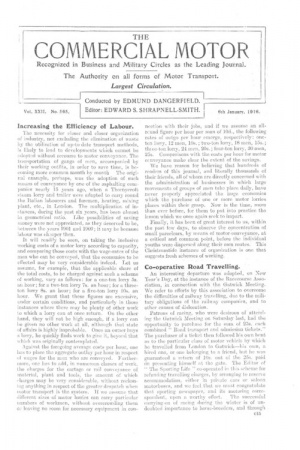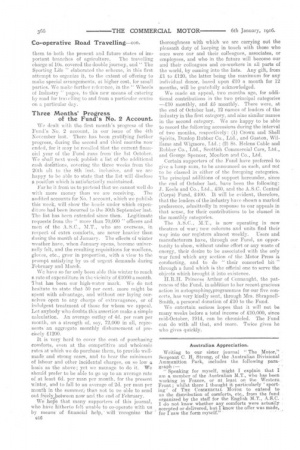COMMERCIAL MOTOR
Page 1

Page 2

If you've noticed an error in this article please click here to report it so we can fix it.
Recognized in Business and Military Circles as the Leading Journal.
The Authority on all forms of Motor Transport. Largest Circulation.
Increasing the Efficiency of Labour.
The necessity for closer and closer organization of industry, not excluding the elimination of waste by the, utilization of up-to-date transport methods, is likely to lead to developments which cannot be adopted without recourse to motor conveyance. The transportation of gangs of men, accompanied by their working outfits, in order to save time, is becoming more common month by month The original example, perhaps, was the adoption of such means of conveyance by one of the :asphalting com• panics nearly 15 years ago, when a Thornycroft steam lorry and trailer wore adapted to carry round the Italian labourers and foremen, heating, mixing plant, etc., in London. The multiplication of instances, during the past six years, has been almost
in geometrical ratio. Like possibilities of saving money were not appreciated, as they deserved to be, netween the years 001 and MO; it may he because labour was chL,aper then.
It will readily he seen, on taking the inclusive working costs of a motor lorry according to capacity, and comparing those costs with the wage-rates of the men who can bc conveyed, that the economies to be effected may be very considerable indeed. Let us assume, for example, that the applicable share of the total costs,. to be charged against such a scheme of working, vary. as follows: for a one-ton lorry 5s. an hour; for a' two-ton lorry .7s. an hour ; for a threeton lorry 8s. an hour; for a five-ton lorry 10s. an hour. We grant that these figures are excessive, under certain conditions, and particularly in those instances where there may be plenty of other work to which a lorry can at once return. On the other hand, they will not be high enough, if a lorry can be given no other work at all, although that state of affairs is highly improbable. Once an owner buys a lorry, he quickly finds work to give it, beyond that which was originally contemplated.
Against the foregoing average costs per hour, one has to place the aggregate outlay per hour in respect of wages for the men who are conveyed. Furthermore, one has to add, in numerous classes of work, the charges for the cartage or rail conveYance of material, plant and tools, the amount of which charges may he very considerable, without reckoning anything in respect of the greater despatch when motor transport is the system. If we assume that different sizes of motor lorries can carry particular numbers of workmen, without overcrowding them or leaving no room for necessary equipment in con
nection with their jobs, and if we assume an allrcund figure per hour per man of 10d., the following rates of outgo per hour emerge, respectively: oneton lorry, 12 men, 10s.; two-ton lorry, 18 men, 15s. ; tin eeAon lorry, 24 men, 20s.; four-ton lorry, 30 men, 25s. Comparisons with the costs per hour for motor cenveyance make clear the extent of the savings.
We have reason for believing that hundreds of readers of this journal, and literally thousands of their friends, all of whom are directly concerned with the administration of businesses in which large movements of groups of men take place daily, have never properly appreciated the huge economies which the purchase of one or more motor lorries places within their grasp. Now is the time, more than ever before, for them to put into practice the lesson which we once again seek to impart.
Finally, it has been of great interest to us, within the past few days, to observe the concentration of small parcelcars,. by mean S of motor-'conveyance, at a critical and common point, before the individual youths were dispersed along their own routes. This Christmastide instance of organization is one that suggests fresh schemes of 1,vorking.
Cooperative .Road Travelling.
An interesting .departure was adopted, on New Year's Day, at the instance of the Racecourse Association, in connection with the Gatwick .Meeting. We refer to effOrtis by this association to overcome the difficulties of railway travelling, due to the Military obligations of the .railway companies, and to other causes of dislocation.
Patrons of racing, who Were desirous of 'attending the Gatwick Meeting on Saturday last, had the opportunity to purchase for the sum of 25s.. each combined " Road transport and admission tickets." The purchaser of a ticket then followed his own bent as to the particular class of motor vehicle by which he travelled from London to Gatwick—his own, a hired one, or one. belonging. to. a friend, but he was guaranteed a return of 10s. out of the, 25s. paid r.in presenting himself at the gate. The Editor of The Sporting Life " co-operated in this scheme for refunding travelling charges, by arranging to reserve accommodation, either in private cars or saloon motorbuses, and we feel. that we must congratulate that sporting newspaper, and its motoring cone-.
spend emit, upon a worthy effort. The successful carrying-on of racing during the winter is of undoubted importance to horse-breeders, and through. •
Co•-operative Road Travelling—con.
them to both the present and future states of im portant .branches of agriculture. The travelling charge of 10s. covered, the double journey, and " The Sporting Life " elaborated the scheme, in this first attempt to organize it, to the extent of offering to make special arrange.thents, at higher cost, for small parties. We make further reference, in the " Wheels of Industry " pages,to this new means of catering by road for travelling to and from a particular centre on a particular day.
Three Months' Progress of the Fund's No. 2 Account.
We dealt with the-first month's progress of the Fund's No. 2 account, in our issue of the 4th November last. • There has been gratifying further progress, during the second and third months now ended, for it may he recalled that the current financial year of the Fund runs' from the 1 st October. We shall_next week. publish i list Of the additional cash donations, covering the three weeks from the 20th ult to the 8th inst. incluSive, and we are happy to be able to state that the list will disclose a position which is satisfactorily maintained.
Far be it froth us to pretend that we cannot well do with more Money than we are receiving. The audited accounts for No. 1 account, which we publish this week, will shoW the heads under which expenditure had been incurredto the 30th September last. The list has been extended since then. Legitimate requests from the " more than 70,000 " officers and men of the A.S.C., M.T., who are overseas, in respect of extra comforts, are never heavier than during the morith of January. The effects of winter weather have, when January opens, become universally felt, and the resulting requisitions for woollens, gloves, etc., grow in proportion, with a view to the prompt satisfying by us of urgent demands during February and March.
We have so far only been able this winter to reach a rate of expenditure in the vicinity of 1000 a month. That has. been our high-water mark. We do not hesitate to state that 50 per cent, more might be spent with advantage, and without our laying ourselves open to any charge of extravagance, or of indulgent treatment of those for whom we appeal. Let anybody who doubts this assertion make a simple calculation. An average outlay of 4d. per man' per month, on a strength of, say, 72,000 in all, represents" an aggregate monthly disbursement of pmcik;ely It is very hard to cover the cost of purchasing comforts, even at the competitive and wholesale rates 'at which we do purchase them, to provide wellmade and strong cases, and to bear the minimum of labour and other incidental charges, on so low a basis' as the above; yet we manage to do it. We should prefer to be able to go up to an average rate of at least 6d. per man per month, for the present winter, and to fall to an average of 2d. per man per month inthe summer,, than not to oe able to send out freeVetween now and the end of" February. We...hope that many supporters of this journal, who have hitherto felt unable to co-operate with us.
by means" 'of 'financial help, "recognize -the' • G16 thoroughness with which we are carrying out the pleasant duty of keeping in touch with those who once were our and their colleagues, associates, or employees, and who in the future will become our and their colleagues and co-workers in all parts of the world, by coming into the lists. Any gift, from to n20, the latter being the maximum for any individual donor, based upon a month for 12 months, will be gratefully acknowledged.
We made an appeal, two months ago, for additional contributions in the two principal categories monthly, and £5 monthly. There were, at the end of October last, 12 names of leaders of the industry in the first category, and nine similar names in the second category. We are happy to be able to record the following accessions during the interval of two months, respectively: (1) Crown and Shell Spirits, Dunlop Rubber Co., Ltd., and Gaston, Williams and Wigmore, Ltd.; (2) St. Helens Cable and Rubber Co., Ltd., Scottish Commercial Cars, Ltd., and George Spencer, Moulton and Co., Ltd.
Certain supporters of the Fund have preferred to give a lump sum, to be announced as such, and net to be classed in either of the foregoing categories. The principal additions of support hereunder, since the end of October last, have been the following': J. Keele and Co., Ltd., 250, and the A.S.C. Central (Corps) Fund, £400. It will be evident, therefore, that the leaders of the industry have shown a marked preference, admittedly in response to our appeals in that sense, for their contributions to be classed in the monthly categories.
The A.S.C., M.T., is now operating in new theatres of war; new columns and units find their way into our registers almost weekly. Users and manufacturers have, through our Fund, an opportunity to show, without undue effort or any waste of energy, their desire to be associated with the only war fund which any section of the Motor Press is conducting, and to do " their concerted bit " through a fund which is the official one to serve the objects which brought it into existence.
H.R.H. Princess Arthur of Connaught, the patroness of the Fund, in addition to her recent gracious action in autographingwrogrammes for our five concerts, has very kindly sent, through Mrs. ShrapnellSmith, a personal donation of .10 to the Fund.
We entertain serious hopes that it will not be many weeks before a total income of £10,000, since mid-October, 1914, can be chronicled. The Fund can do with all that, and more. Twice gives he who gives quickly.




















